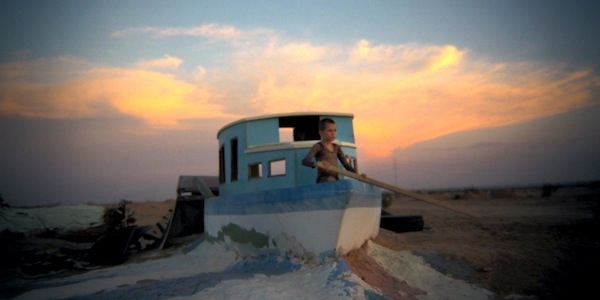Now a ghost town and home to a mere 295 residents, the town itself is a harsh reminder of its own hey day in the ‘50s where tourists, the wealthy and famous all flocked to the Californian desert. Even Frank Sinatra and the Beach Boys frequented Bombay Beach, soaking up the sun, artificial lake and mud volcanoes. Location scouting for a music video for the band Beirut led Har’el to Bombay Beach where she met Benny and Mike, whom she instantly became captivated by.
“Their parents came to the beach afterwards, told me their stories and I just felt really comfortable with them. I thought they were incredible characters. I wanted to get back and do a whole film with them.” Har’el then met CeeJay – who finds Bombay Beach a haven unlike the other residents – and who fled from California after his cousin was murdered. Red, an elderly resident of the town was first described to Har’el by a hitchhiker like the character of folklore. “When I met Red I couldn’t help wanting to write down everything he said.”
The characters are as intriguing as Har’el insists, each of them contrasting to their environment and each other. Each of the characters has to survive their environment (which ultimately represents death) in order to survive life. Benny, a child who suffers from bipolar, creates suffering and happiness through his disorder. Red, an ancient survivor lives comfortably in his environment, mobile, without anything. CeeJay views Bombay Beach as his sanctuary, the opportunity to escape the city; the town provides him with the opportunity to go to college. “You see how nothing is one thing and how many realities there are in a certain place,” Har’el comments.
Har’el’s cinematography provides the viewer with an enchanting view of life as a resident in Bombay Beach. She focuses on inanimate objects; beat up cars, washing lines, washed-up fish on the shore. When questioned about her decisions to focus on inanimate objects, Har’el explains, “I guess still objects fascinate me just as much as people do.”
Her infatuation with landscape is portrayed throughout the film as dreamy long shots provide the viewer with a perception of the environment shaping each of the characters’ lives. The excessive use of landscape and object shots is essential in accompanying the film’s storyline. The landscapes show just how desolate and poverty-stricken Bombay Beach is. The opening sequence of the film, a collection of found film and audio from the ‘50s and ‘60s, juxtaposes the representation of the town throughout the entirety of the film. It is within the first frames of the film that the hey day of Bombay Beach is exhibited, including tourists jet skiing, using the $500,000 luxury yacht club and having picnics on the sea’s shore. Opening the film using found film was debated over by Har’el for some time until the final days of postproduction. “It was something I debated till the last minute about whether we should have that in the film or not. When you know a place that is beautiful and promising, you understand the nature of it, and when [you] position it next to the American dream gone ruined, mutated, forgotten. I don’t know how you want to look at it. I felt like it gave the film some context without taking to much out of the illusive qualities that that place have, the dreamy qualities that it has.”
Bob Dylan and Beirut make up the soundtrack, echoing the residents’ experiences through Har’el’s selections of tracks. She comments, “in general, Beirut’s music and Bob Dylan’s music really make me feel close to myself and life.” The soundtrack perfectly sits with the narrative, providing the viewer with an additional portrayal of the desert experience. The track A Series of Dreams by Dylan always reminded Har’el of the character Red as she drove to Bombay Beach, a lyrical commentary on his and the residents’ experiences in the desolate town. When asked to justify her reasoning for each of the songs within the film, Har’el responds by suggesting the films soundtrack shouldn’t be analysed instead, just “felt”.
There is little to fault in this film, a visually and narratively enchanting commentary of a town we know little about and residents we know even less about. Har’el takes the audience on a tour of the washed-up dead fish, washing detergent guzzling children and hopeless adults. The characters are equally as enchanting as each other, Benny, the child suffering from bipolar, a stand out. There is something so surreal about the town and the fascination with ghost towns and Salton Sea that immediately follows (after watching the film). Har’el has portrayed a place unknown to many that is so haunting and inspiring at the one time. The film tempts you to explore Bombay Beach records, listen to Beirut and Bob Dylan in the sun and dance like a child at the front of your house.
BY BRIGITTE TROBBIANI

